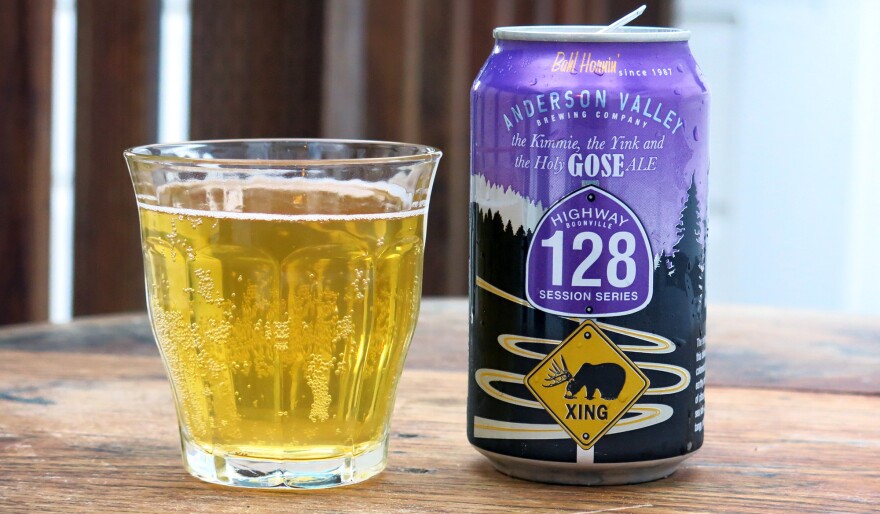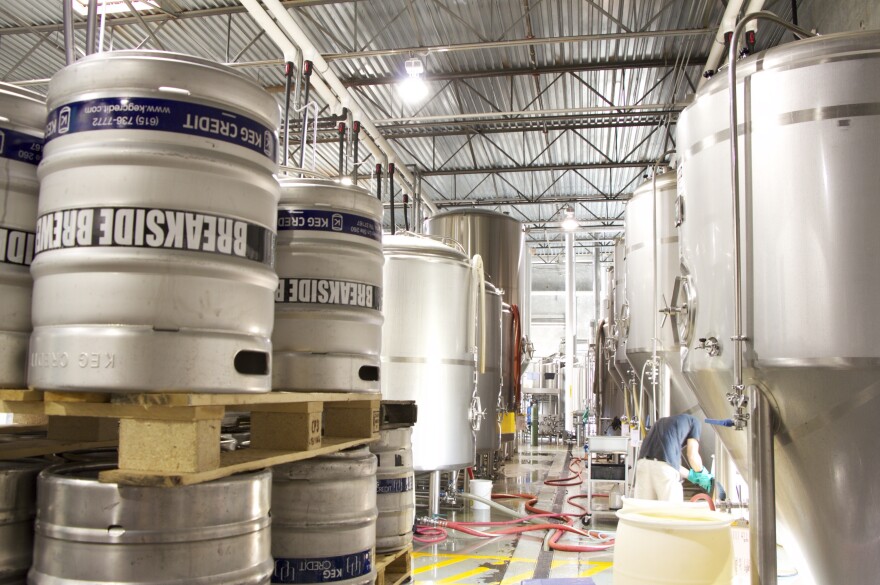If you're tuned into the world of beer, you may be aware of sour beers — a loosely defined style that has been made for centuries but is gaining fresh appreciation in today's craft beer renaissance. Brewers make these beers by deliberately adding bacteria and, sometimes, wild yeast to the brew, then letting them age slowly. It sounds weird, but sours can be delicious — tart and earthy, and redolent of things like leather, fruit and wood.
They're also very hard to make, requiring months or years of letting the beer gradually mature in the cellar. And all the while, brewers must take extra precautions to prevent the souring microbes from bursting out and contaminating the rest of their nonsour beers — a major logistical hitch and expense. That's why some brewers refuse to make sours: They're too much trouble. And those who do make them sell the beers at high prices, often $5 or $6 for a dainty 6-ounce sample.

But a technique that makes brewing sour beers fast and easy is trending across America — making sours much more affordable. The technique is called kettle souring, and it allows brewers to produce a mouth-puckering sour in about the same time it takes to make any other beer. The result can be generous pours of acidic, face-twistingly refreshing beer for the standard price of a pint.
In Portland, Ore., breweries like The Commons and Gigantic are serving tall glasses of kettle-soured beer for between $4 and $5, while nearby Breakside Brewery is selling bottles of kettle-soured beers for just $6. (Breakside sells bottles of traditionally made sours for as much as $18.) The kettle-souring trend is also taking off in breweries in St. Louis and Kansas City, Mo., Charlotte, N.C., and Missoula, Mont.
Kettle-soured beers use some of the same critters as traditional sours to achieve a crisp, sharp tang: bacteria of the Lactobacillus genus, which munch on the sugars in beer and convert them into acids, while also turning out flavors and aromas. Some brewers will even use a dollop of yogurt made with Lactobacillus cultures to kettle sour their beers. (Traditional sours often also use Pediococcus bacteria and Brettanomyces yeast, but right now, most brewers who use kettle souring rely on Lactobacillus.)
But the key reason kettle-soured beers can be made cheaper is a change in the usual order of operations.
With traditional souring, the microbes are added after the beer has fermented. That means hop oils and alcohol are already present in the beer. But hops can hinder bacteria, and alcohol slows down yeast. That's one main reason why the traditional souring process can take a long, long time — and part of the reason sour beers are intentionally made with few or no hops.
By contrast, with kettle souring, the microbes are added before the beer is fermented, so they can do their job quickly — literally, overnight in some cases, according to Lance Shaner, co-owner of Omega Yeast Labs, a company in Chicago that sells liquid Lactobacillus culture. Even when the souring takes several days, it's still lightning fast compared with barrel souring.
Once the beer hits the desired level of acidity, it is then boiled to kill the souring agent. That eliminates the need for added safeguards — like a whole separate set of brewing equipment — to keep the microbes from escaping and unintentionally fouling other beers in the same brewery.

The kettle-soured beer is then fermented and hopped, as usual. All in all, kettle souring means less cost, and less time.
"So you're only adding an extra day to the production time," says Ben Love, the brewer at Gigantic Brewing.
It may seem like a dream come true for brewers who, for financial and logistical reasons, have been unable to brew sour beers before.
"Before, we didn't have the money, the space, the time, and all the separate vessels, and tubes, and clamps that you usually need to make sours, so when I heard about this fairly straightforward method of making them, I got really, really interested," says Dave Wohldmann, the brewer at Square One Brewery and Distillery in St. Louis.
But there is a drawback to kettle-soured beers: They aren't quite as good as traditionally made sours, according to most sources. They are clean and refreshing — but without the flavor complexity that months or years in a microbe-ridden barrel can create.
That's because traditional sours are often made with a more diverse mixture of microbes than kettle sours — like Pediococcus bacteria and Brettanomyces yeast. These critters churn out oodles of extra flavors and aromas, like malic acid, citric acid and fatty acids, says Ben Edmunds, brewmaster at Portland's Breakside Brewery.
Time, also, is of the essence in making complex, flavorful beers — and time, says Cory King, owner of Side Project brewery in St. Louis, is "one of the things you really can't substitute for in brewing." King first dabbled in kettle souring three years ago but now makes mostly traditional, barrel-soured beers, which he says are far more interesting.
Jeff Grant, the owner and brewer at Draught Works, is also a fan of making kettle-soured beer, but he doesn't make them as stand-alone brews. Rather, Grant has been using his kettle-soured beer as an acidic blending ingredient to add to other beers. Edmunds, at Breakside Brewery, uses the same technique — much the way winemakers combine different wines to create a final product.
"[Kettle souring] is an awesome tool for brewers to keep in their back pocket to add acidity to a beer," Edmunds says.
He adds that kettle souring makes a unique and very simple style of its own — but it doesn't compare to traditional sour styles, like lambics and Flanders red ales.
In fact, Edmunds says he is a little worried that brewers might try to use kettle souring to produce fast and simplified renditions of these slow-soured styles.
"I really hope that brewers who embrace kettle souring see that it's not just a replacement for all those other aging processes that take more time, and which took hundreds of years to develop."
Copyright 2021 NPR. To see more, visit https://www.npr.org.






